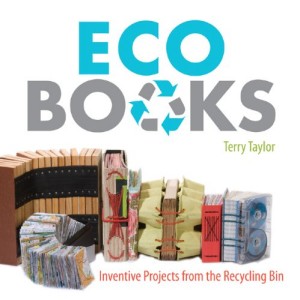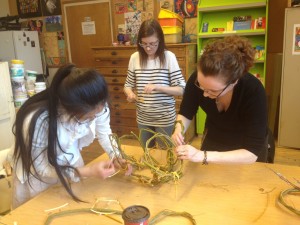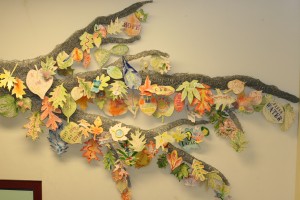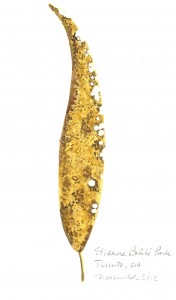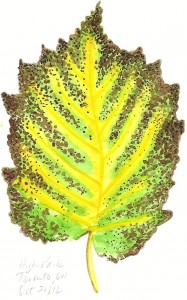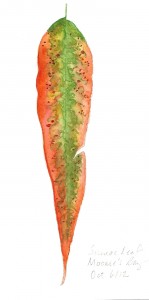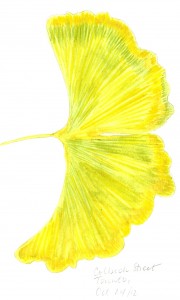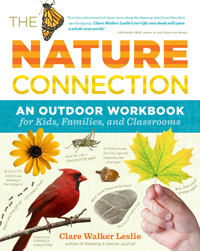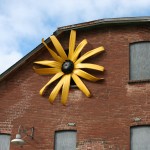While Iãve been busy with collaborative eco-art installations with my students this winter, summer always gives me a little more time to work on my personal artworks.ô Iãve been experimenting with sculptural book-making in recent years ã I love the combination of text and image, and the surprise of taking a traditionally flat object and making it come alive in three dimensions.ô So how do you make this technique more eco-friendly?ô Working with paper is a first step as it is easily biodegradable – that’s a natural when it comes to book-making.ô But Iãve also been drawing inspiration from a variety of sources, looking for ways to incorporate natural or found objects into my bookworks.ô I love the Spirit Books of Susan Kapuscinski Gaylord (http://www.susangaylord.com/the-spirit-books.html), who uses branches, grapevine and dried berries in this evocative book series.ô Mary Ellen Campbellãs books also incorporate a range of natural materials, often layering one on top of the other for a beautiful effect (find examples of her work on Pinterest.)ô Basi Irland takes a very different approach, freezing water and seeds into book forms that become part of a community performance as they float downstream (http://www.basiairland.com).ô If youãre looking for exemplars of how to re-use found objects and turn them into books, look no further than Terry Taylorãs EcoBooks: Inventive Projects from the Recycling Bin.ô Once youãve read this book, youãll be excited to try this yourself ã youãll be seeing possible books in everything you discard!
Nature is the best art supply store!
The snow is just melting here, and we Canucks are emerging from the comfort of our well-insulated abodes to rediscover the beauty of a warmer natural world.ô I get excited about the idea of my gardens starting to grow again; spring, after a long winter, is always a hopeful time of year.ô One of the things I start to dream about is using more natural materials in my artworks:ô what new material can I find?ô What new material will find me?ô Nature is the best art supply store; the materials are plentiful, inexpensive, biodegradable, and if harvested properly, sustainable as well. ô I often get asked about the ethics of harvesting natural materials, especially in urban spaces; I think that, in many ways, going all natural is more ethical than using manufactured materials.ô The latter typically has a much bigger ecological footprint, and is more toxic, so moving to biodegradable materials can certainly be a positive step in the right direction.ô But ensuring that you are finding sustainable sources of natural materials, that don’t harm their living sources, is crucial.ô So a few ideas for including more natural materials in your art-making:
- painting on leaves, rocks, or bark
- dyeing fabric with natural dyes made from onions, beets, red cabbage, etc.
- creating collages made with natural materials
- pressing natural materials into wet clay to make tiles or ãfossilsã
- rubbings of natural textures (leaves work beautifully for this)
- blowing bubbles with food dye and pressing onto paper
- making handmade paper with natural components such as seeds or leaves
- using branches as ãframeã for weavings
- using beeswax as pigment or adhesive
For more ideas, check out the following website:
Art and your Natural Environmentô ô http://arts.umich.edu/programs/funpages/environmentart/
Working with Willow
I had a Toronto artist, Morgan Zigler, do a workshop for my teacher candidates on working with willow in the spring; we had a great time! Itãs an easily-renewable, accessible, (often free) natural material to work with, making it just about as sustainable as it gets. We had a lot of fun learning the basics of working with willow, and making a few sculptures for the OISE Learning Garden ã a few photos of my students at work are below. Morgan has done a lot of this type of work at Evergreen BrickWorks, modelling how to use hands-on, experiential learning very effectively with youth; he has also done some great installations with using living willow in schoolyards.ô You can check out his website at:
http://foolishnature.org/homely/environmental/wood/wood.html
If you want to really take this to the zenith with your students, check out the work of Patrick Dougherty; he uses willow and other types of branches to create the most amazing natural architectural works!ô ô His website is beautiful in its own right, and contains lots of photos of his work:ô http://www.stickwork.net/ô Guaranteed to get any learner excited about the possibilities of working with willow!
Turning Over a New Leaf
How can you help your students turn over a new leaf when it comes to living more sustainably on the earth?ô I asked my pre-service students to do just that this year, and not surprisingly they gave a range of responses, from recycling to upcycling, to doing more with less, to hatching new ideas.ô This inspired their latest eco-art project, which has just been installed at OISE.ô I introduced them to the field of eco-art in a workshop, and then together we created over a hundred clay leaves that capture their ideas in both text and image, which were glazed and fired.ô Working with artist/student Angela Johnson, we created a large metal branch on which to hang the vibrant leaves.ô As this work hangs in our stairwell as part of the Take the Stairs energy conservation campaign, we hope that Turning over a new Leaf will help others think about how they can take positive change towards sustainability in their lives and those of their students, one step at a time!
Teaching and Learning in the OISE Eco-art Projects
No time to blog last month – weãre midway on the OISE eco-art projects, and it’s been busy!ô Weãve got four projects underway, thanks to efforts of my dedicated students, as I couldnãt have done that many on top of teaching and research duties this last month.ô Iãm working on a nature-based mural project with a class of grade 1s at our lab school, the Institute of Child Study, in collaboration with the art teacher, Tara Rousseau.ô We have 2 8 ft. high murals underway with the students, demonstrating what they have learned about tree habitats this last fall.ô Tara and I have also been working alongside OISE student Stephanie Heim and a grade six class who are creating a clay tile installation based on the Environmental Rights of Children, and OISE student Hayley Chown, who has been working with the grade 5s to create energy conservation stickers for the light switches at OISE.ô Another team of OISE students, Aidan Hammond, Wynette Tavares and Nikolaos Katsiou, are running eco-art workshops to explore their fellow studentsã conceptions of nature.ô
Lessons are being learned (and re-confirmed) each time we step into the classroom ã about how creative kids are, how knowledgeable they are about the world around them, and how adults enjoy the process of art-making just as much as kids, even if they havenãt done it since their own childhoods.ô Weãre striving to be an environmentally-friendly as possible with the materials we are using ã by capturing waste water from the acrylic paints’ clean-up, by aiming for waste minimization, and by using naturally-derived materials like clay.ô But these projects have also been a good reminder that contemporary art supplies are not particularly sustainable in their composition or their use, and that there is a huge need for more eco-friendly materials.
Weãre also working on dealing with the typical challenge of public art projects.ô One of the reasons weãre using clay is that it is inflammable – one of the conditions of installing artworks in the stairwells as they are a fire evacuation route.ô If anyone has information on the fire ratings of art supplies Iãd love to hear about it!ô More to come on these projects shortlyãÎ
Does nature make art?
The fall has gotten away from me as usual ã so much work to get a new academic year up and running.ô But I have been making more space to make art this fall ã Iãm finding this a necessary component in achieving my own version of work-life balance.ô My latest project has been looking more closely at the way nature makes art all on its own ã or perhaps the way that I frame it as art through my own personal lens.ô Inspired by the winter workshop I took on nature-journaling last winter, Iãve been drawing from nature on my summer canoe trips and on fall hikes ã Canadian trees in particular are stunning this time of year.ô Leaves have been capturing my attention and inducing me to paint ã small watercolours, replicating and riffing on the colours and shapes that I find aesthetically pleasing.ô Iãm up to about thirty of them, and will keep at it until the leaves are gone and winter and settled in.ô Iãm going to turn them into a handmade book, along with some of my thoughts on art/nature connections.ô Iãm attaching a few images to share ãhoping to inspire others to look at the beauty and aesthetic interventions all around in every season.ô
Get outside and draw!
I had the pleasure recently of attending a workshop led by naturalist Clare Walker Leslie, who is a prolific artist and author.ô Clare is a passionate proponent of art-based nature journalling, well-evidenced in her many journals.ô Seeing her journals is a delight ã they are rich with drawings of the natural world, observations, and connections to her experiences.ô Her drawing style is beautiful ã in some cases, quick and gestural to capture the shape of a bird before it flies off into the bush; in others, detailed, well-worked watercolours or coloured pencil drawings created in her studio from outdoor sketches and field guides.ô She spends a lot of time in classrooms with students, encouraging them to use drawing (or mark-making, as she prefers to call it) as a way to closely observe the flora and fauna around them ã an important step towards developing their ecological literacy.ô Clare delivered three workshops in Toronto, including one at the Master of Teaching Environmental Education conference at OISE.ô It was refreshing to get outside ã yes, even in a cold Ontario winter ã just to draw, and to be reminded of the power of journaling as an ongoing learning activity for learners of all ages. ô For more info on Clare, or to order one of her books, please visit her website at:ô ô
Art Education & Eco-Awareness
As part of a conference I presented at in the fall (All Hands in the Dirt, at Evergreen Brick Works) I was asked to present on how to keep students making art outside when the weather turns cold.ô That day we did some outdoor stenciling, but it reminded me of the power of taking art learners of all ages outside year-round to learn from the natural world.ô A colleague in the States, Heather Anderson, has written a new book on just this topic thatãs worth a look:ô Art Education & Eco-Awareness:ô A Teacherãs Guide to Art and the Natural Environment.ô This resource is a compilation of art lessons on land, water, sky, plants and wildlife, all accompanied by colour illustrations of professional artistsã work on these themes and exemplars of childrenãs work.ô For those looking for new ideas to get your students outside to make art all year long, this is a great start.ô Itãs available from Davis Publications: ô ô
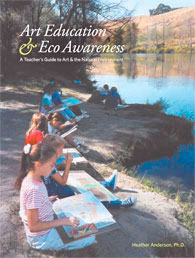
New ideas growing in BC
Spring has finally sprung in Toronto after a long winter, and I feel like new ideas and approaches to eco-art education are popping up around me like tulips and daffodils!ô Iãve been busy finishing off a year of teaching, writing, and presenting at conferences, hence the lack of blogging.ô But in my travels Iãve been meeting some fascinating artists and educators, all dedicated to more sustainable ways of art-making.ô One of these is an artist from Vancouver named Sharon Kallis ô ô What caught my eye was her work with natural materials, in particular invasive species; I hadnãt thought of art-making as a way to creatively re-purpose the biomatter that comes from getting rid of large amounts of plants like English Ivy (in BC), grapevine or dog strangling vine (here in Ontario.)ô Sharon has done some really interesting things with the ivy in particular, so check out her website to learn more ô [http://sharonkallis.com/community-engaged-practice/]
Another project I learned about recently is also from Vancouver ã I met jil p. weaving at the same time as Sharon.ô This project took its starting point from the destructive wind storm that hit Stanley Park in 2006, and used artists as one of its ways of addressing the physical and emotional damage caused by this event.ô In many ways, I think it presents a model for how to deal with environmental damage in sensitive and innovative ways.ô Check it out at [http://www.stanleyparkecology.ca/programs/public/SPEA.php].
Green Arts at Evergreen Brick Works
I have been lucky over the last year to be involved in a small way in the thinking around ãGreen Artsã at the new Evergreen Brick Works site, which has just opened in Toronto in October. Evergreen Brick Works is quickly becoming the environmental community centre of the city, with environmental education programs for schools, a plant nursery of indigenous plant species, a series of demonstration gardens, and a wonderful market featuring organic and fair trade food. It will also become the centre of environmental arts in Canada over time, acting as a much needed hub for artists, musicians, dancers and actors who share similar goals in sustainability through their practice.
The rejuvenation of the site is an art installation in its own right ã the century old brick kilns and factory buildings are taking on a new life as classrooms, meeting places, exhibit spaces and performance venues. Artist-in-residence Ferruccio Sardella worked closely with the architects to ensure that the some of the patina and history of these spaces was left intact, including some of the existing street art, like the large graffiti murals that were created on the walls years ago. Ferruccioãs own works are slowly being added to the site, not only to build its own eco-art collection but also to materialize Evergreenãs ideals in aesthetic form. Other works on site include Dan Bergeronãs large-scale photo murals of the former brick workers in the kiln buildings, and art videos inside the kilns themselves!
Landscape architect Heidi Campbell is working on a creative, interactive space for children to play and create their own eco-artworks made of natural and found materials ã this should be ready for the spring of 2011. Artists Shannon Crossman and Morgan Zigler have been supporting its development by sharing their innovative activities with children and families in the childrenãs garden over the past two summers.
Be sure to visit the Evergreen Brick Works website for more info at [http://ebw.evergreen.ca/] or better yet, visit in person!
